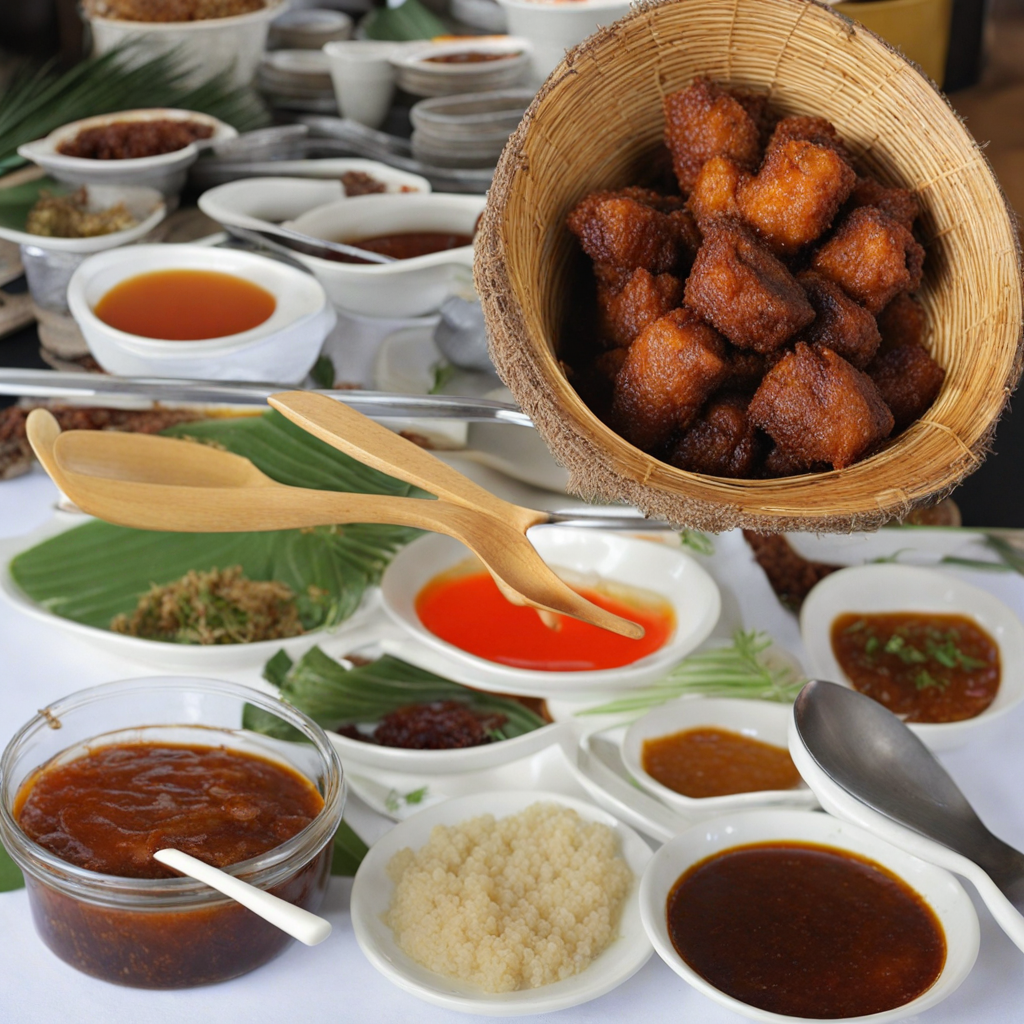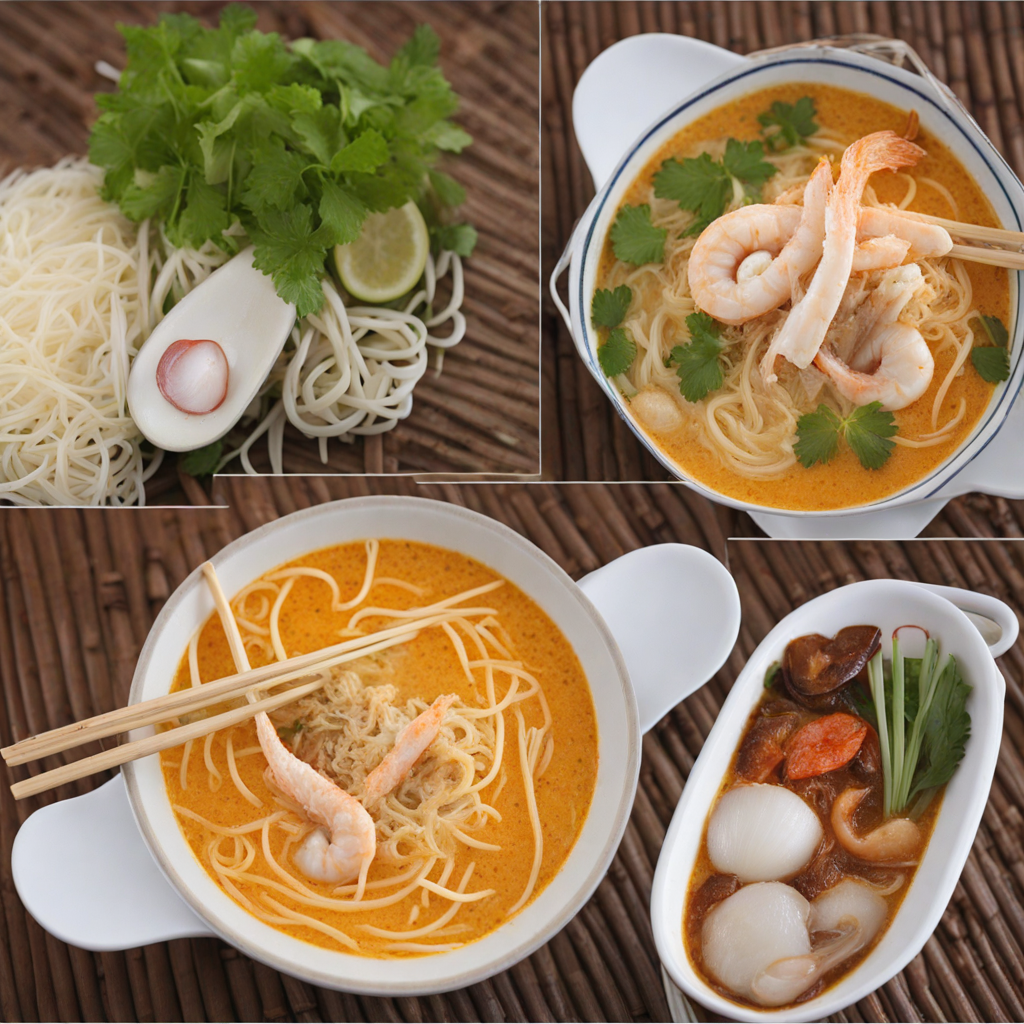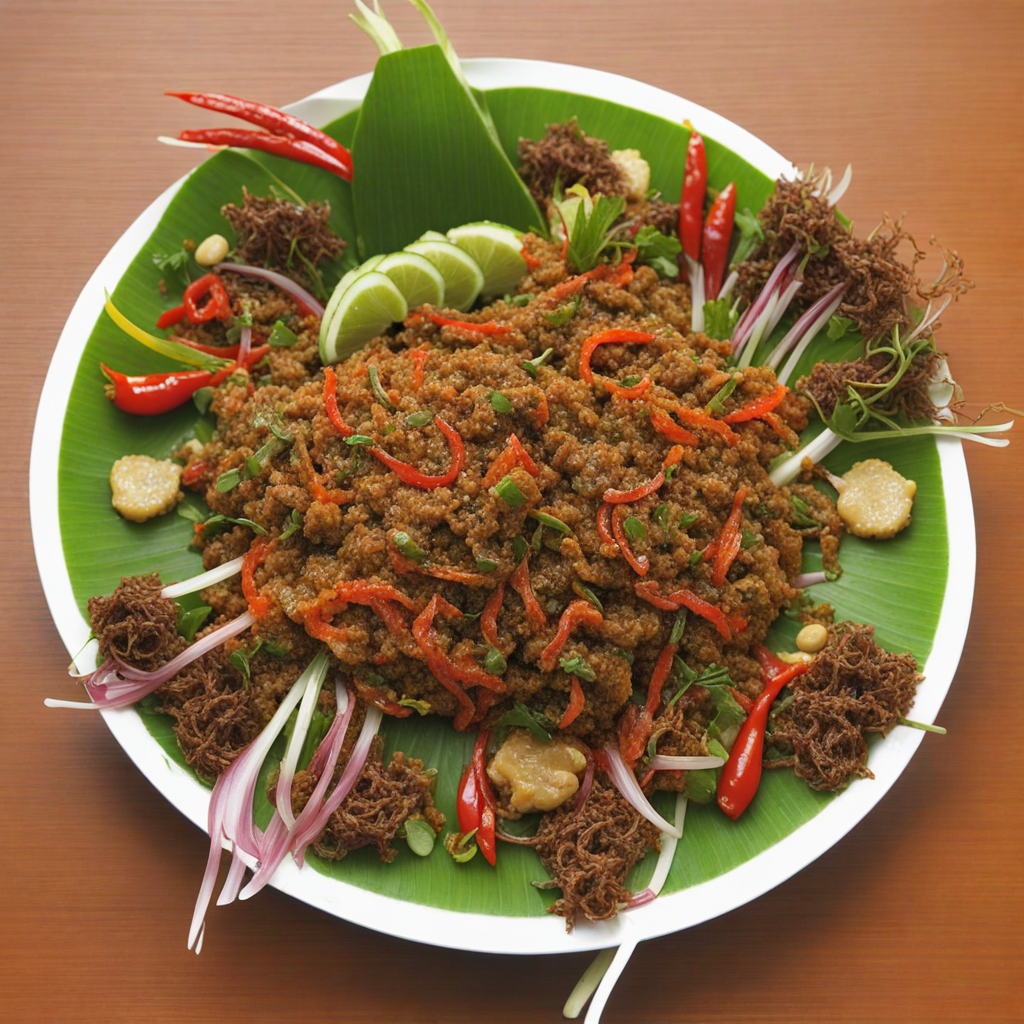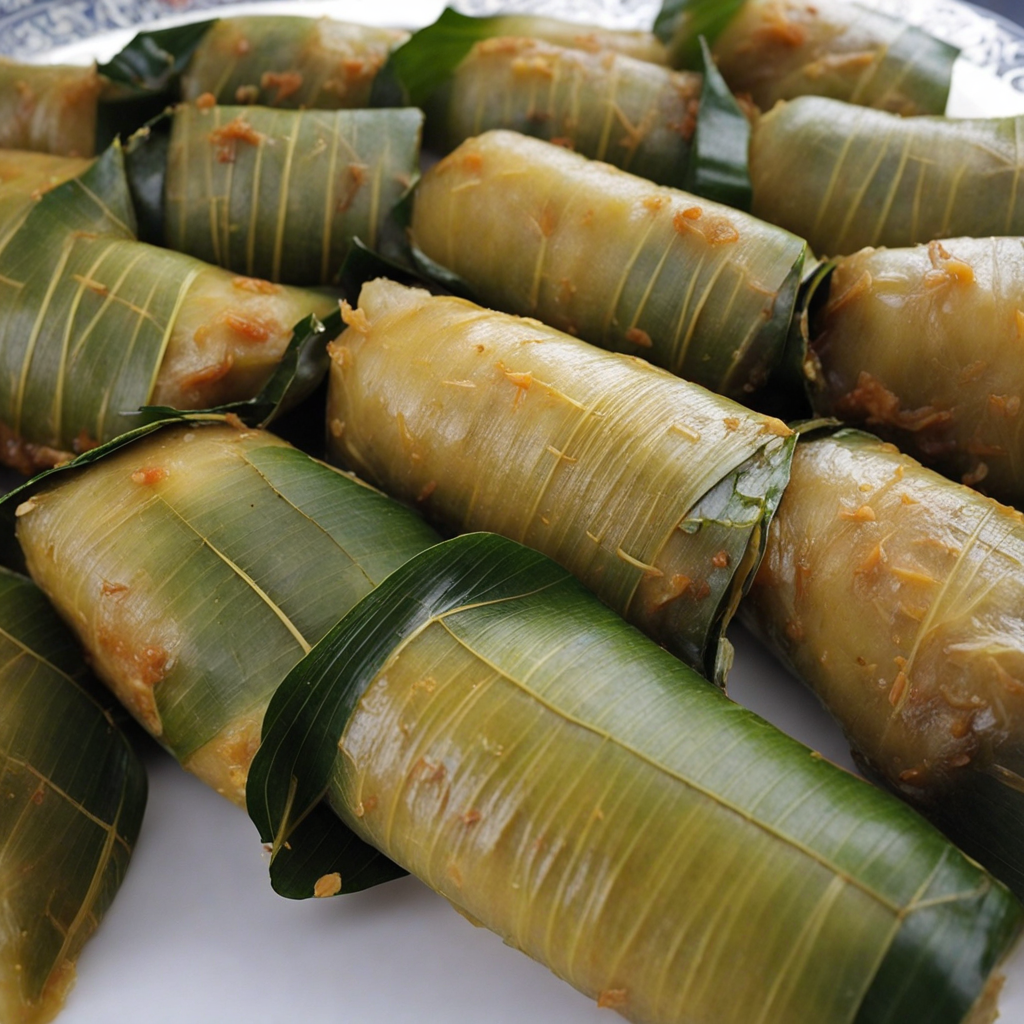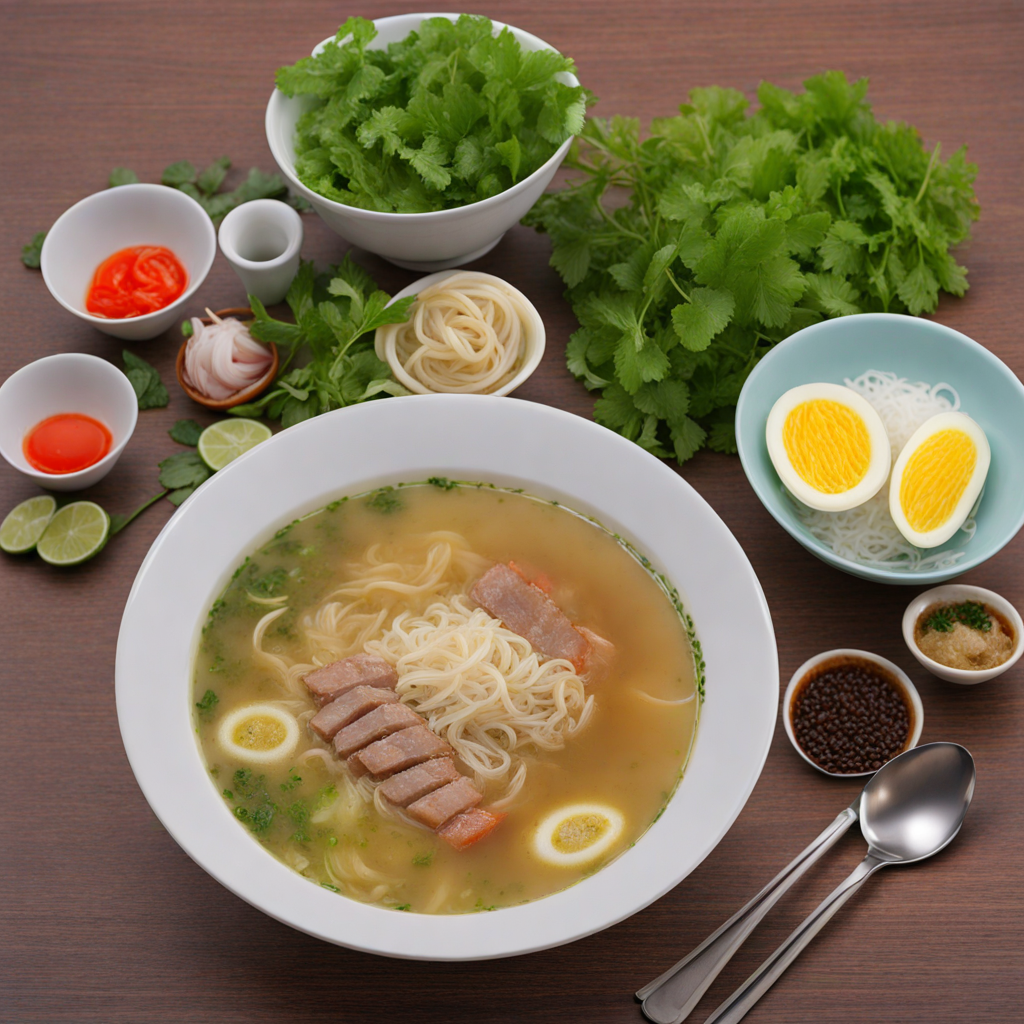Ambuyat
Ambuyat is a unique culinary experience originating from Brunei, made from the pith of the sago palm tree. The preparation of ambuyat involves boiling the sago starch until it reaches a thick, glue-like consistency. This starchy substance is then served as a sticky, translucent mass that is typically enjoyed with the use of a bamboo fork or chopsticks. The texture is both elastic and smooth, providing a remarkable sensation as it is twirled around the fork and lifted to the mouth, making it a delightful addition to any meal. What sets ambuyat apart is not only its texture but also the variety of accompaniments it can be paired with. Traditionally, it is served alongside a selection of dipping sauces, known as 'sambal.' These sauces can range from spicy chili blends to savory peanut pastes, each offering a burst of flavor that complements the mild taste of ambuyat. The combination of the neutral starch with a bold sambal creates a balance that is both satisfying and memorable, allowing for a personalized experience as diners can choose their preferred level of heat and flavor. Enjoying ambuyat is not just about the food itself, but also the communal aspect of the dining experience. It is often enjoyed during special occasions and gatherings, where family and friends come together to share this traditional dish. The act of swirling the ambuyat around the fork, dipping it into the sambal, and sharing stories creates a warm and inviting atmosphere. For those looking to explore new tastes, ambuyat presents an opportunity to delve into Brunei’s culinary heritage while enjoying a dish that is both simple yet rich in culture.
How It Became This Dish
The History of Ambuyat: Brunei's Unique Culinary Heritage #### Origins of Ambuyat Ambuyat, a traditional dish from Brunei, is a fascinating culinary marvel that reflects the rich cultural heritage of the nation. Its origins can be traced back to the indigenous Malay communities that have inhabited the region for centuries. The dish is made primarily from the sago palm (Metroxylon sagu), a staple tree in the diet of many Southeast Asian communities. The processing of sago into ambuyat involves extracting the starch from the palm's pith, which is then mixed with water to create a thick, sticky paste. The sago palm is often referred to as the "tree of life" in these regions due to its vital role in providing sustenance. The harvesting process is labor-intensive, involving the felling of the palm, followed by the extraction of the sago from the trunk. This labor was traditionally carried out during communal gatherings, reinforcing social bonds among the people. Over time, ambuyat became synonymous with Bruneian identity, transforming from a simple sustenance food into a symbol of cultural pride. #### Cultural Significance Ambuyat is more than just a dish; it embodies the cultural essence of Brunei. It is often served during special occasions, family gatherings, and communal feasts, celebrating the significance of togetherness in Bruneian society. The preparation and consumption of ambuyat are ritualistic, emphasizing communal values and the importance of shared meals. The dish is usually accompanied by a variety of side dishes, such as fish, meats, or vegetables, and is served with a tangy dipping sauce made from sambal, a chili-based condiment. This combination allows for a diverse flavor profile, catering to different palates and elevating the overall dining experience. In Brunei, ambuyat is not just food; it is a medium through which cultural narratives are passed down from generation to generation. It is often associated with the stories and traditions of the Malay people, encapsulating their history and way of life. Elders often share tales of their childhood experiences with ambuyat, reinforcing its presence in the collective memory of the community. #### Development Over Time As Brunei has evolved through the ages, so has ambuyat. The dish has seen adaptations and innovations while remaining true to its roots. Historically, ambuyat was a food of necessity for the rural communities, but with urbanization and the effects of globalization, its role has transformed. In recent decades, ambuyat has gained recognition beyond Brunei, becoming a point of interest for food enthusiasts and tourists alike. One significant development is the introduction of ambuyat to the global culinary scene. As Brunei has opened up to international tourism, ambuyat has become a culinary ambassador for the country. The dish is often featured in food festivals and cultural exhibitions, highlighting Brunei's unique culinary heritage. Food bloggers and travelers have documented their ambuyat experiences, leading to a surge in interest and appreciation for this traditional delicacy. Moreover, the preparation of ambuyat has also evolved with modern culinary techniques. While the traditional method of preparing ambuyat remains cherished, contemporary chefs are experimenting with flavors and presentations, incorporating international influences while paying homage to the traditional roots. This fusion approach has helped keep ambuyat relevant in the rapidly changing food landscape. #### Modern-Day Ambuyat In contemporary Brunei, ambuyat is often served in restaurants and is a common feature in festive banquets. It is a dish that encapsulates the spirit of hospitality, with hosts taking pride in serving ambuyat to their guests. The dish has also found its place in the culinary offerings of Brunei’s neighboring countries, demonstrating its versatility and appeal. While ambuyat remains a beloved traditional dish, it also faces challenges in the modern world. The sago palm, while abundant in certain regions, is threatened by deforestation and land conversion for agriculture and development. As awareness of environmental sustainability grows, there is a concerted effort among local communities to promote responsible sago harvesting practices. This ensures that ambuyat can continue to be enjoyed by future generations, preserving both the ecological and cultural landscapes of Brunei. #### Conclusion Ambuyat is much more than a mere dish; it is a symbol of Brunei’s cultural tapestry, weaving together the threads of history, community, and identity. From its humble origins in the forests of Borneo to its current status as a culinary icon, ambuyat encapsulates the resilience and adaptability of Bruneian culture. As Brunei navigates the complexities of modernization and globalization, ambuyat stands as a testament to the enduring power of traditional foods, reminding us of the importance of preserving cultural heritage in an ever-changing world. In celebrating ambuyat, we acknowledge not only the rich culinary traditions of Brunei but also the values of community, heritage, and sustainability that this unique dish represents. Whether enjoyed in a bustling restaurant or at a family gathering, ambuyat remains a cherished element of Bruneian life, inviting both locals and visitors to partake in its rich history and cultural significance.
You may like
Discover local flavors from Brunei


